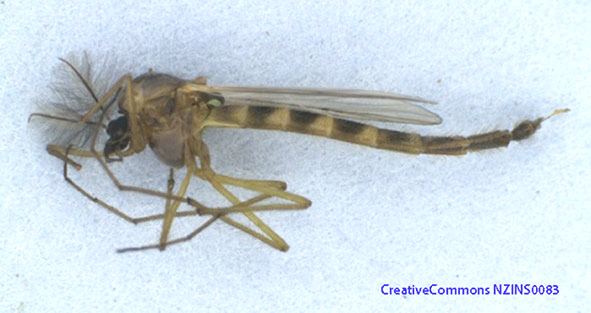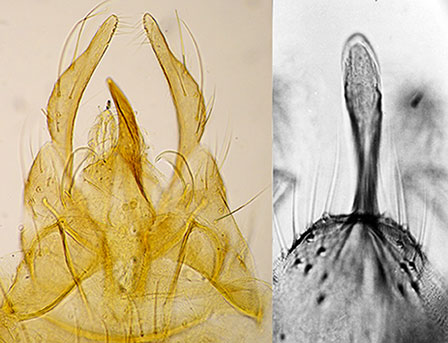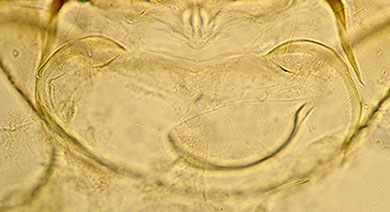Although originally allocated the name Chironomus novae-zelandiae, such names are no longer acceptable under the Code, and it should now be Chironomus novaezelandiae In BOLD BIN: BOLD AAJ0168 and BOLD ABZ5458
BOLD ABZ5458 is the nearest neighbor-Bin to BOLD AAJ0168 and the reason for the separation is possibly the presence of polymorphic sites in C. novaezelandiae in which one base is identical to the fixed base in C. spNZ12 (see below).
C. 'thermarum' is also a member of this species group and is also in Bin BOLD AAJ0168. Type specimens - for original descriptions see Types of C. novaezelandiae. Freeman (1959) named a male from Wellington as lectotype, although erroneously placing the species as a synonym of C. zealandicus since he had no information on the immature stages.Data from other specimens: The identification of the current material as C. novaezelandiae is based on the similarity to the specimens in the type series, plus the broad distribution of the species. However, it is quite likely that the type series is also a mixture of members of the C. novaezelandiae species group.

Male of C. novaezelandiae from BOLD database (NZINS-83)Wing length about 4.06-5.93 mm; width about 0.88-0.96 mm, VR about 1.02; 3 setae on brachiolum, 27-32 setae in squamal fringe. AR about 3.2-3.6.
Head: small frontal tubercles about 10-15 µm; long and 7.5 µm wide; 15-23 setae on clypeus. Palpal segments (micron): 58 : 60 : 250 : 249 : 354, P5/P4 1.01-1.42; P5/P3 1.39-1.62.
Thoracic setae: Acrostichal - not seen; Dorsocentral - 12-17; Prealar - 5-6; Scutellar in roughly two rows, 4-10 anterior and 11-12 posterior (total 15-22).
Anterior tibiae and tarsus bearded, with mainly shorter setae (BR about 3) and sparse longer setae (i.e. essentially a sparse long beard).
Leg lengths (micron) and proportions:
| Fe
| Ti
| Ta1
| Ta2
| Ta3
| Ta4
| Ta5
| LR
| F/T
| BR
| PI
| 1560
| 1495
| 1925
| 1205
| 845
| 665
| 340
| 1.23-1.36
| 1.01-1.05
| 3.9-6.5
| PII
| 1680
| 1685
| 945
| 625
| 460
| 315
| 225
| 0.55-0.57
| 0.96-1.02
|
| PIII
| 2050
| 2147
| 1385
| 910
| 675
| 440
| 260
| 0.63-0.65
| 0.94-0.95
|
| BR - double beard only measured from one specimen: short 3.3, sparse long 4.5Abdominal tergites with brown bands covering the basal 2/3 of TII-VI, wider in midline than at edges, and about 4/5 of tergites VII and VIII. About 10.3 (4-15) setae in a pale patch on tergite IX.

Male terminalia (left), and Anal point (right)Hypopygium: Superior volsella hooked, of E(h)-type, of Strenzke (1959); Inferior volsella reaching almost to the end of the long anal point which is narrow at the base and expanded at the end (about midpoint of gonostyle) with more-basal setae of Inferior volsella ramose. Gonostylus only moderately swollen and reducing markedly over distal third. Females:
Osten-Sacken female - see Types of C. novaezelandiae. Other females:
Wing length 4.43 (3.96-4.88) mm, width 1.20 (0.96-1.40) mm; VR 0.89 (0.81-0.98, about 3-4 Scf on brachiolum, and about 22-25 setae in squamal fringe.
Head: Antennal proportions (micron)(propn of neck in brackets): 197 (0.31); 139 (0.42); 145 (0.33): 143 (0.43): 241. AR 0.40 (0.37-0.44); A5/A1 1.16 (1.14-1.30).
Frontal tubercles about 23-35 µm; and 3-3.6 times longer than wide; palpal segments (µm) 100 : 68 : 230 : 260 : 387; P5/P4 1.34-1.53; P5/P3 1.41-1.91.
Clypeal width about 1.6 times the diameter of the antennal pedicel; 44.3 (41-51) setae.
Thoracic setae: Acrostichal - 14.25 (12-19); Humeral about 3-5 linear incl. perhaps 3 small setae, Dorsocentral - 16-30 (Humeral + Dorsolateral 26.8 (19-34)); Prealar - 6.8 (5-9; Supra alar - 1; Scutellar - anterior row 10-27, posterior row 12-20 (Total 22-47).
Leg lengths (micron) and proportions:
| Fe
| Ti
| Ta1
| Ta2
| Ta3
| Ta4
| Ta5
| LR
| F/T
| Ta4/Ti
| PI
| 1467
| 1320
| 1860
| 1027
| 767
| 620
| 327
| 1.38-1.44
| 1.11
| 0.45-0.50
| PII
| 1520
| 1480
| 833
| 493
| 360
| 333
| 207
| 0.56-0.57
| 0.95-1.06
|
| PIII
| 1787
| 1853
| 1240
| 760
| 580
| 353
| 233
| 0.63-0.69
| 0.94-1.00
|
| BR 1.63-2.21 Abdominal tergites with darkened bands, at anterior of TII to TIV then more extensive. 
Terminal region of female showing the narrow semicircular segment X, and the rounded posterior margin of the cercusSegment X a narrow semicircle about 210x34 µm (6 times longer than its greatest width); cerci also appear to be essentially semicircular. It is still likely that this is a mixture of at least two species, as there seem to be two types of arm G: one with no apparent nucleolus and with a large subterminal and medial BR (G1) (the latter moved distally in G2), and another with a subterminal nucleolus and often without an obvious BR (G3), or with a BR very close to the nucleolus - but other than the presence or absence of the nucleolus or BR, the sequence appears identical.
MtCOI data suggests a common variable species and a possible second less common form. This seems to represent the difference between the sequence of C. novaezeandiae (common & variable) and C. spNZ12. These two species differ at a number of sites in the barcode sequence, with somewhat more differences from C. 'thermarum' (see below).
The pupa differs from that of C. zealandicus in that the spines of the spur are appressed, while those of C. zealandicus are splayed. DNA analysis:
MtCOI - a number of sequences in the BOLD database. These sequences are for 3 or 4 species spread across 2 BOLD Bins. There are however distinct differences at a number of sites, as shown below. Type 1 is designated on the basis that this is the form found at Wellington Ð the designated type locality. C. novaezelandiae Ty. 1
T
| G
| C
| T
| T
| A
| T
| A
| T
| C
| A
| T
| A
/
G
| T
/
C
| T
| C
| T
| T
| A
| T
| C
/
T
| C
/
T
| A
| T
| G
/
A
| G
/
A
| T
/
C
| A
| C
| A
| T
/
C
| T
/
C
| T
/
C
| T
| G
| T
/
C
| C. novaezelandiae Ty 2
T
| A
| C
| T
| T
| A
| T
| A
/
g
| T
| C
| A
| T
| G
| T
/
C
| T
| C
| T
| T
| A
| T
| C
| C
| A
| T
| A
| A
| C
| A
| C
| A
| T
| C
/
t
| T
| T
| G
| C
/
g
|
T
/
G
| A
/
T
| C
| G
/
T
| T
| A
| A
| G
| T
| C
| A
| T
| A
| C
| T
| C
| T
| T
| A
| T
| C
| C
| A
| C
| G
| A
| T
| C
| C
/
G
| C
| T
| T
| T
| A
| A
| T
|
T
| A
| T
| T
| A
| T
| A
| G
| A
| T
| C
| A
| A
| T
| A
| T
| C
| C
| T
| C
| T
| T
| G
| C
/
T
| G
/
A
| A
| T
| C
| C
| C
| T
| T
| T
| A
| A
| T
| MtcytB - GenBank (AF192178.1) Occurs in a wide variety of habitats, from lakes to pools, including thermal waters, and fresh to brackish. While there may be more than one species still included, the available DNA data is consistent with this wide habitat tolerance. Known Localities This appears to have been the "thummi-type" studied by Robb (1966). It is referred to as C. zealandicus Type I by Lentzios & Stocker (1979) and Lentzios et al. (1980), who reported a nucleolus only in arm F. They received most of their material from Long Point. Go to Immatures and cytologySee also C. 'spilleri', C. 'thermarum' and C. species NZ12.[ Return to Key| Go to References ] |


